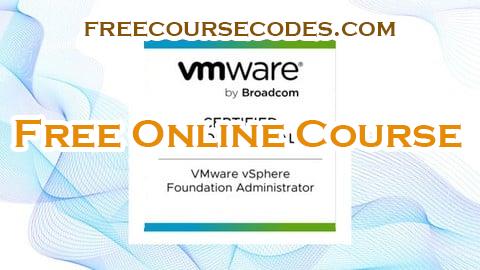
- Promoted by: Anonymous
- Platform: Udemy
- Category: IT Certifications
- Language: English
- Instructor: Yassine Chffori
- Duration:
- Student(s): 281
- Rate 0 Of 5 From 0 Votes
- Expires on: 2025/09/08
-
Price:
94.990
VMware Certified Professional - VMware vSphere Foundation Administrator (2V0-16.25) PRACTICE EXAM
Unlock your potential with a Free coupon code
for the "VCP VMware vSphere Foundation Administrator (2V0-16.25) EXAM" course by Yassine Chffori on Udemy.
This course, boasting a 0.0-star rating from 0 reviews
and with 281 enrolled students, provides comprehensive training in IT Certifications.
Spanning approximately
, this course is delivered in English
and we updated the information on September 05, 2025.
To get your free access, find the coupon code at the end of this article. Happy learning!
This intensive, hands-on course prepares infrastructure and platform engineers to install, configure, secure, automate and operate a VMware vSphere Foundation (VVF) environment aligned to the 2V0-16.25 certification objectives. You will learn how to deploy and manage vCenter and ESXi, design and operate vSAN and networking, provision VMs and cloud-native workloads (vSphere Pods, VM Service, VKS), use VCF Operations for monitoring/alerts/logs/costing, and automate Day-2 operations with Orchestrator and Aria Automation Config (SaltStack). The course emphasizes real-world scenarios, decision making, and performance-based problem solving.
Who this course is for
System / platform administrators preparing for the VMware Certified Professional — vSphere Foundation Administrator (2V0-16.25) exam.
Infrastructure engineers who manage or will manage VMware Cloud Foundation / vSphere Foundation deployments.
DevOps engineers who need to understand platform operations, VM Service and Supervisor-based workloads.
Architects who design VCF/VVF solutions and need operational knowledge.
Learning outcomes (what learners will be able to do)
After completing the course, learners will be able to:
Deploy and configure vCenter, ESXi hosts and vSphere clusters ready for Workload Management.
Design, deploy and tune vSAN (ESA/OSA), create storage policies and configure space-efficiency and resilience models.
Configure VDS and NSX-T networking options for Supervisor and workload traffic; troubleshoot common network issues.
Provision, manage and troubleshoot virtual machines, Content Library workflows, and VM Service CRD-based provisioning.
Deploy and manage Supervisor Services, vSphere Pods, Tanzu Kubernetes workloads and VM Service workloads.
Configure and operate VCF Operations: dashboards, alerts, logs ingestion, storage and chargeback/costing.
Automate Day-2 operations using VCF Orchestrator and Aria Automation Config (SaltStack) — author modular actions and trigger remediation.
Implement identity, RBAC, certificate management and license management for secure multi-tenant operations.
Monitor and enforce security hardening and compliance (CIS/NIST style checks), detect drift and implement remediation workflows.
Apply best practices for HA, scaling, operational runbooks and production readiness checks.
Course outline (modules & key activities)
Module 1 — Foundations & Lab Setup (3–4 hours)
Course orientation, exam mapping and success strategy
Lab environment walkthrough (Hands-On Labs, nested ESXi or cloud lab)
Quick refresher: virtualization, Linux/Windows admin, networking basics
Hands-on: Provision lab VMs, configure Content Library access
Module 2 — Deploy & Configure Compute (6–8 hours)
vCenter deployment options and Day-2 integration points
ESXi host installation, host profiles, vLCM overview
Creating clusters, HA/DRS basics, admission control
Hands-on: Deploy vCenter, add ESXi hosts, configure cluster basics
Module 3 — vSAN Storage Fundamentals (6–8 hours)
vSAN ESA vs OSA: architectures and use cases
Disk groups, policies, storage classes and space-efficiency features
Resilience options (FTT, RAID-1/RAID-5/6 equivalents), troubleshooting common vSAN issues
Hands-on: Build vSAN cluster, create storage policies, run health checks
Module 4 — Networking for VVF (6–8 hours)
VDS vs NSX-T: when to choose what, Supervisor transport nodes
Load balancers, overlay/tunnel considerations, Kubernetes networking concepts
Troubleshooting flows, port/MTU/segmentation best practices
Hands-on: Configure VDS/transport nodes, simulate network failure and troubleshoot
Module 5 — Provisioning Virtual Machines & VM Service (6–8 hours)
Content Library, templates, OVAs, and VM provisioning best practices
VM Service concepts: VirtualMachine CRD, VM classes, images, manifests & GitOps patterns
Day-2 VM lifecycle (snapshots, backups, migration)
Hands-on: Create templates, provision VMs via UI and VM Service (CRDs)
Module 6 — Supervisor Services, vSphere Pods & Kubernetes (6–8 hours)
Enabling Workload Management / Supervisor cluster prerequisites
vSphere Pods, TKC/TKG (VKS), and Supervisor Services (Harbor, Contour, Argo CD)
Namespace governance, quotas and RBAC for tenants
Hands-on: Enable Supervisor, deploy a Supervisor Service, deploy a vSphere Pod and a TKC
Module 7 — VCF Operations: Monitoring, Logs & Storage Operations (6–8 hours)
VCF Operations components: Fleet, Operations, Logs, Storage Operations, Chargeback
Dashboards, Analyze/Logs, Alerts, Policies and Views; setting up cost/rate cards
Hands-on: Integrate vCenter with Operations, build dashboards, create alerts, ingest logs
Module 8 — Identity, Certificates & Licensing (3–4 hours)
Identity Broker/SSO integration, role mapping and RBAC patterns
Centralized certificate management, renewal workflows
License management and reporting best practices
Hands-on: Configure Identity Broker, assign roles, renew a certificate
Module 9 — Automation & Orchestration (6–8 hours)
Aria Automation Config / SaltStack integration: use-cases for configuration management
VCF Operations Orchestrator: Actions, Workflows, locking and best practices
Build automations: remediation on alert, lifecycle tasks, and connectors (REST/webhook)
Hands-on: Create an Orchestrator action, wire it to an alert and run a remediation workflow
Module 10 — Security, Compliance & Day-2 Runbooks (4–6 hours)
Security hardening checklists, compliance baselines and drift detection
Applying policies (CIS/NIST), remediation via automation, vulnerability and advisories monitoring
Operational runbooks: backups, recovery, capacity planning, performance tuning
Hands-on: Run compliance scans, create a remediation workflow, simulate drift
Module 11 — Scenarios, Case Studies & Exam Prep (4–6 hours)
Real-world case studies: multi-tenant deployment, edge/single-node Supervisor, disaster recovery scenario
Practice performance-based tasks and multiple-choice exam simulations
Final Q&A, exam readiness checklist, resources
Labs & practical requirements
Strongly recommended: lab with nested ESXi or cloud-based hosts (64 GB RAM recommended for deeply practical labs).
Hands-on steps include: vCenter deployment, adding ESXi, vSAN build, Supervisor enablement, Content Library setup, VM Service manifests, Aria Automation Config integration, Orchestrator workflows, and Operations dashboards.
If you lack local hardware, Hands-On Labs or a hosted lab subscription is acceptable for most exercises.
